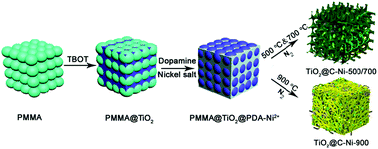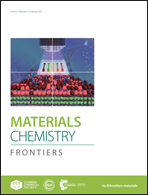Anchoring nickel nanoparticles on three-dimensionally macro-/mesoporous titanium dioxide with a carbon layer from polydopamine using polymethylmethacrylate microspheres as sacrificial templates†
Abstract
The performance in adsorption and catalysis efficiency are closely dependent on the morphology and structure of the catalysts and adsorbents. Herein, three dimensional (3D) macro-/mesoporous TiO2@C–Ni composites were successfully fabricated using polymethylmethacrylate (PMMA) as a sacrificial template. Notably, the inorganic interlayer of TiO2 or SiO2 played an essential role in generating such 3D macro-/mesoporous TiO2(SiO2)@C–Ni composites. In the absence of TiO2 or SiO2, aggregated C–Ni composites were obtained instead. Owing to the well-defined 3D macro-/mesoporous structures as well as high coverage of Ni nanoparticles (NPs), the TiO2@C–Ni composites obtained at 500 °C in a N2 atmosphere exhibited excellent performance in catalysis and protein adsorption. Moreover, the morphology of the 3D TiO2@C–Ni composites was greatly influenced by changing other different carbonization temperatures (700, 900 °C). Interestingly, when PMMA@TiO2@PDA–Ni2+ was annealed at 900 °C, all of the generated carbon nanotubes as well as the TiO2 interlayer were weaved together into a continuous 3D network, which will endow this kind of material with enhanced properties and excellent performance in energy storage fields.



 Please wait while we load your content...
Please wait while we load your content...